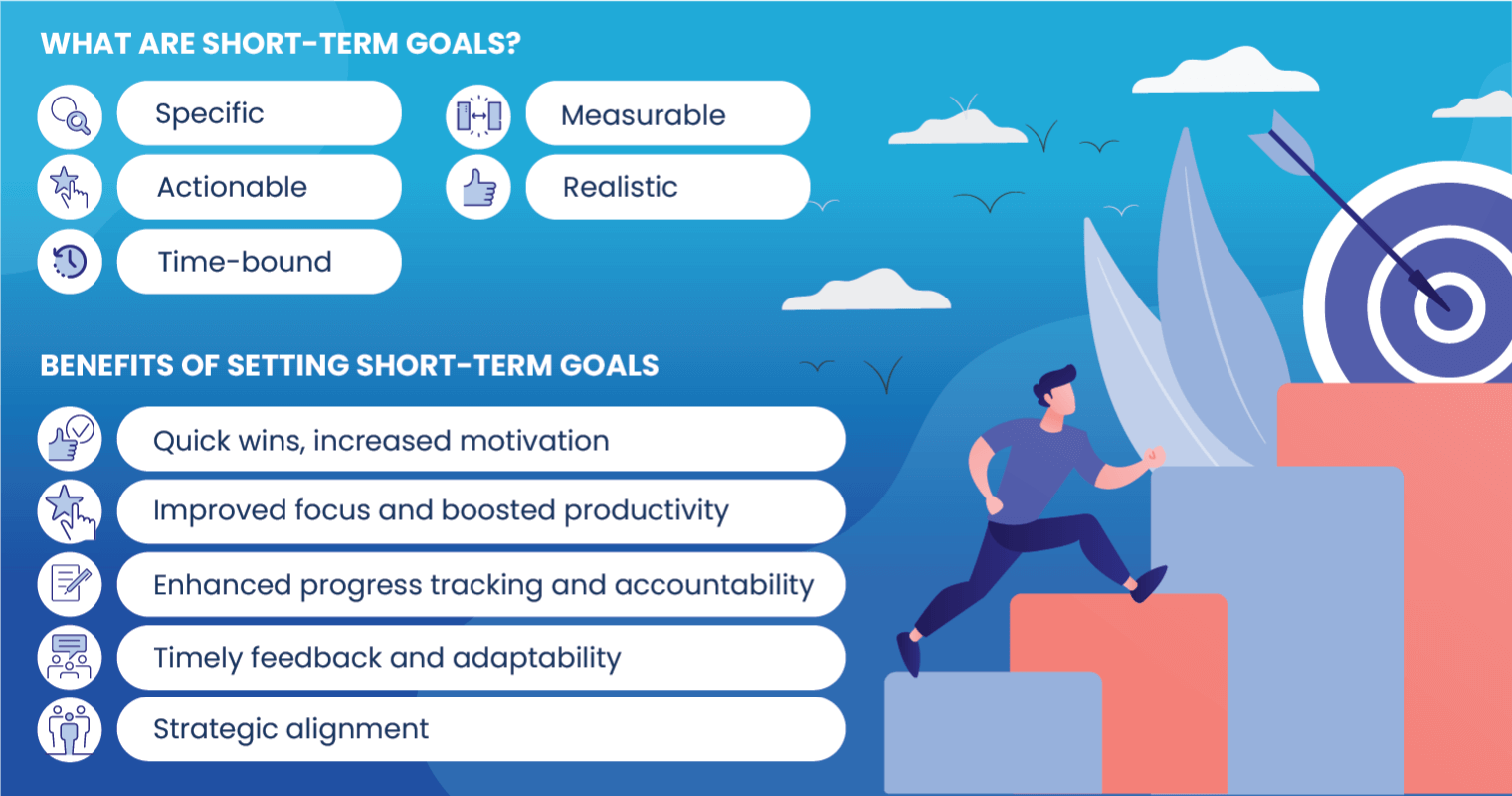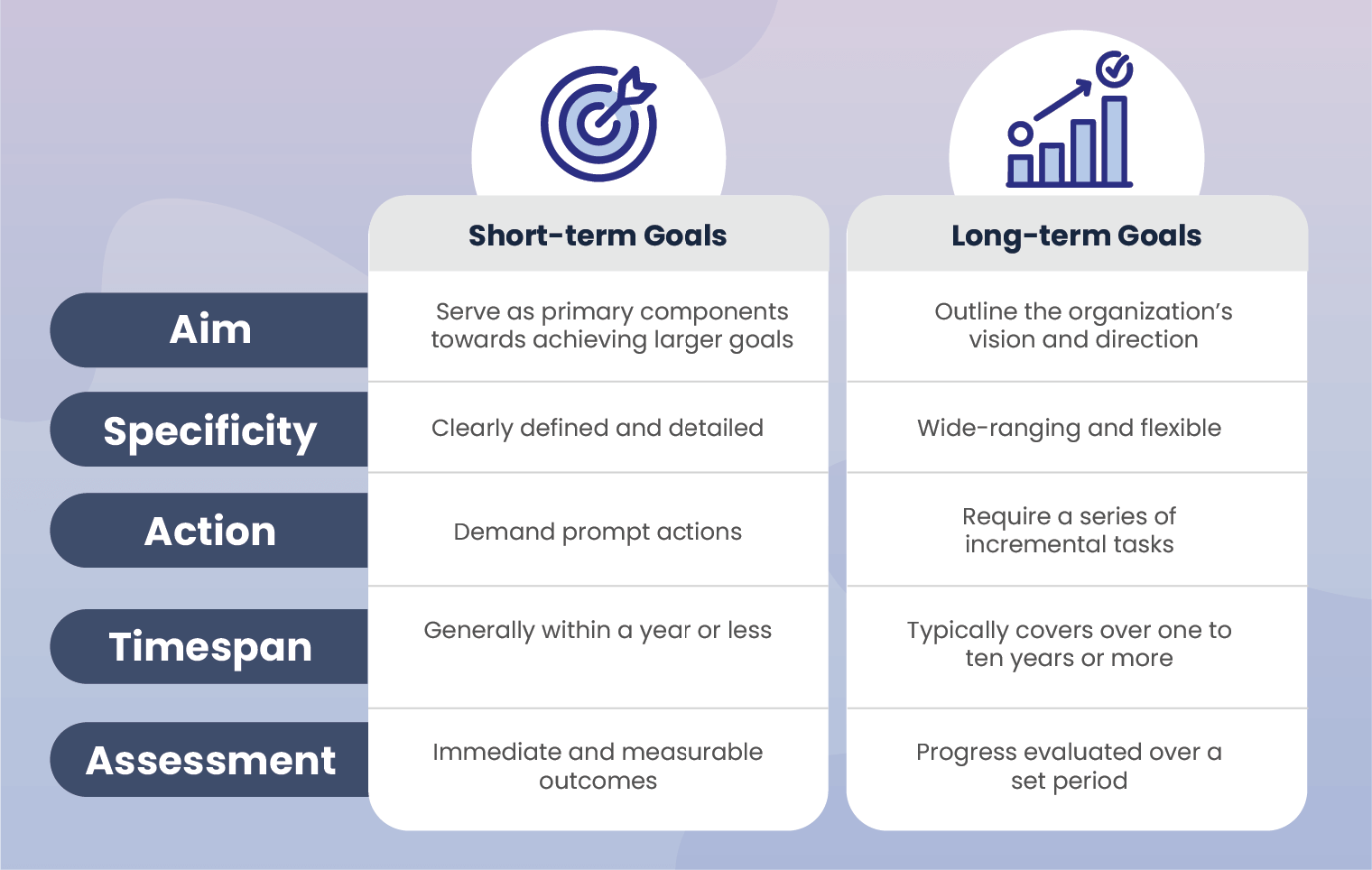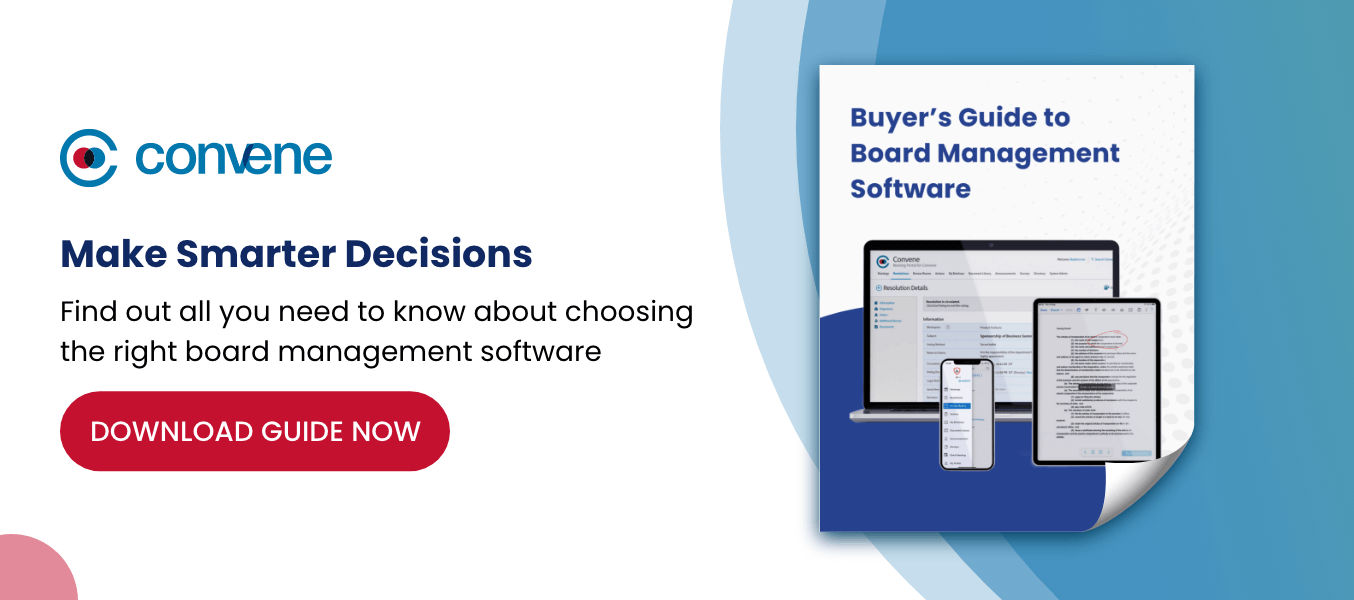Everyone wants to achieve something either in the next 10 years or in the next 6 months. You may be looking to check off something in a matter of weeks or strive to accomplish a decade-long plan. Whether personal or professional, short-term and long-term goals provide direction and purpose to our actions.
Similarly, corporations and nonprofits rely on these goals to steer their efforts and define their success. Whether you’re looking to make an immediate impact or planning for sustainable growth, understanding and implementing effective goal-setting strategies is crucial for your nonprofit’s success.
In this guide, we will explore the differences between short-term and long-term goals, the benefits of setting both, and provide practical tips on how nonprofits can establish and achieve their objectives.
What are short-term goals?

Short-term goals refer to the business targets you want to achieve within a relatively short time frame, usually within weeks, months, or up to a year. These goals can vary widely, from completing daily operations to achieving small victories that build momentum toward your long-term vision.
Effective short-term goals are often referred to as SMART goals, which stands for Specific, Measurable, Achievable, Relevant, and Time-bound.
- Specific – Short-term goals should clearly define and align with your nonprofit’s mission. Specific goals are easier to visualize and act upon, providing clear direction for your efforts.
- Measurable – Short-term objectives should be calculated and tracked over the set period. These should have key performance indicators or metrics that can be used to quantify results. Measurability gives a logical picture of success.
- Actionable – Goals should outline clear actions needed to achieve them. Such clarity helps in tracking progress and ensures that everyone understands the steps required for success.
- Realistic – Goals should be realistic and achievable, given the available resources and time frame. Setting overly ambitious short-term goals can be discouraging if they are not met, so it’s important to balance ambition with practicality.
- Time-bound – A short-term goal takes how long to achieve? Short-term goals have clear deadlines or timeframes for completion. Usually set within a year or less, they are more urgent as they help focus efforts and prioritize tasks.
Benefits of Setting Short-Term Goals
Beyond simply checking off to-do lists, incorporating short-term goals in your nonprofit offers numerous benefits, including:
- Quick wins, increased motivation – Short-term goals provide immediate achievement, increasing motivation among members and volunteers. Such small wins create a momentum of high energy and continued effort towards larger goals.
- Improved focus and boosted productivity – Clear, time-bound goals help staff prioritize tasks, focus efforts, and manage their time and resources. Moreso, short-term goals chunk down your larger tasks, enhancing productivity and ensuring steady progress.
- Enhanced progress tracking and accountability – By focusing on short-term objectives, it’s easier to track progress and hold members accountable. Such transparency helps identify successes and areas needing improvement, allowing for timely adjustments.
- Timely feedback and adaptability – Setting short-term goals enables nonprofits to receive immediate feedback on their efforts. This is crucial for modifying strategies promptly while ensuring the nonprofit stays on the right track.
- Strategic alignment – Nonprofit short-term goals facilitate better alignment with long-term strategic plans. They ensure that each member understands the vision, enacts their roles, and acts towards achieving both short-term and long-term objectives.
Examples of Nonprofit Short-Term Goals
Short-term goals for nonprofits provide immediate targets to drive progress and momentum toward achieving the vision and mission. Here are some common examples:
- Fundraising: Increase monthly donations by 20% through an online crowdfunding campaign and strong donor outreach efforts within the next six months. This goal is crucial for enhancing financial support, donor base, and community involvement.
- Volunteer recruitment: Recruit and train ten new volunteers by the end of the month to support educational advocacy programs. Such goal contributes to increasing manpower, introducing fresh ideas, and potentially securing future donors.
- Donor retention: Improve donor retention by 10% within the next six months by implementing a new donor stewardship program. Regular donors are the lifeblood of most nonprofit organizations, making this a key short-term goal.
- Program delivery: Develop and launch a new program intended for educating underprivileged youth within the next six months. This goal directly supports the overall nonprofit’s mission of forwarding its advocacy.
- Exposure and awareness: Secure five online media features on local websites and social media platforms within two months. Media coverage is crucial in enhancing visibility and credibility.
By setting and achieving these short-term goals, nonprofits can ensure continuous progress, adapt to changing circumstances, and maintain alignment with their long-term mission and vision.
What are long-term goals for nonprofits?
Long-term goals for corporations and nonprofits are objectives set to be achieved over an extended period, typically ranging from one to ten years, or even longer. They serve as the north star, outlining the organization’s path toward success and impact.
Effective long-term goals are designed to be high-level and flexible, allowing your nonprofit to adapt to societal, political, environmental, and technological changes.
Key characteristics of long-term goals include:
- Ambitious and strategic – Long-term goals are ambitious and push your nonprofit to be innovative and maximize its capabilities. Such goals challenge the organization to grow and adapt efficiently to the dynamic landscape.
- Flexible and adaptable – While your long-term goals steer you in an anchored direction, they must also be adaptable to potential future trends and challenges. These traits are necessary to adjust these goals, allowing you to stay on course while navigating new risks and opportunities.
- Mission-driven – Especially in nonprofits, long-term goals must resonate with the organization’s core values and mission. These goals should further the nonprofit’s purpose and advocacy, may it be alleviating poverty, empowering the youth, or protecting the environment.
Benefits of Setting Long-Term Goals
Long-term goals cannot be accomplished immediately, but it has significant benefits for your nonprofits, including:
- Enhanced performance and growth – Long-term goals establish a clear vision and direction, encouraging your staff and members to work towards a common future. Their ambitious nature tends to challenge nonprofits to become more resourceful, fostering innovation and continuous improvement.
- Better decision-making – Nonprofits are expected to make decisions that will ultimately contribute to social impact. However, in cases where decisions are not easy to make, having long-term goals can help you evaluate which options are closer to reaching your vision.
- Sustainability – Demonstrating a clear strategic plan can attract donors and grantmakers by showcasing the nonprofit’s commitment to its mission. Such strategic planning also ensures that you’re relevant in developing programs and services, ultimately showing your commitment to potential funders.
Examples of Nonprofit Long-Term Goals
The long-term vision of nonprofits encompasses sustainability, growth, overall efficiency, and continuous impact. Here are some examples of nonprofit long-term goals.
- Sustainable funding: Build a $20 million endowment fund within 10 years by establishing a diverse and reliable funding stream. Having a strong financial reserve ensures that the nonprofit is capable of risk management and continuity.
- Capacity building: Enhance organizational capacity and improve service delivery by investing in staff development and technology, and strengthening governance structures.
- Program expansion: Expand programs and services in the next five years to reach more beneficiaries by launching new initiatives or scaling up existing programs.
- Advocacy and policy influence: Advocate for systemic change and influence public policy by establishing expertise in a particular field or leading coalitions.
- Public awareness: Enhance the nonprofit’s brand and raise public consciousness of the advocacy by developing comprehensive publicity and communication strategies to effectively tell its story and impact.
- Innovation: Foster a culture of innovation to streamline operations and improve program effectiveness. This can be done by adopting organization software for fundraising, data management, and service delivery. One platform nonprofits can invest in is a board portal, which streamlines board meetings and management workflows.
Setting and pursuing long-term goals can ensure sustained progress, adaptability, and alignment with the nonprofit’s mission — achieving a greater impact on the community.
Short Term vs Long-Term Goals: Differences
To summarize, here’s a table to describe the differences between a short-term goal and a long-term goal.

Which best defines the relationship between short- and long-term goals? Despite their differences, both goals are vital to your nonprofit’s success. Long-term goals set the direction of your short-term goals, guiding your daily actions. Conversely, the results of your short-term objectives affect the achievability of your long-term goals.
Fostering a balance between top-down (long-term to short-term goals) and bottom-up (short-term to long-term goals) approaches can ensure your vision remains relevant and attainable.
How to Set Effective Short-Term and Long-Term Goals For Nonprofits
Setting short-term and long-term goals for nonprofits is essential for fulfilling your nonprofit’s mission while sustaining growth and development. Here are some tips to help you formulate effective goals.

Define your vision
Before you create your goals, start by revisiting your nonprofit’s vision and mission. Engage with stakeholders to identify what’s most important and what defines the organization’s success. Review your core documents to define your purpose and what you want to achieve in the long term.
Identify your SMART goals
When developing your goals, ensure that they embody the characteristics of effective goals. The SMART framework is one way to help formulate goals that are clear and measurable. This framework is particularly effective for creating short-term goals that are actionable and realistic.
Break long-term goals into short-term goals
Long-term goals cannot be accomplished immediately; they require breaking them down into short-term, actionable steps. You can think of these short-term goals as stepping stones or bite-sized SMART tasks that provide a clear direction. Each small goal you achieve can help build motivation and momentum for your nonprofit.
Adjust goals as priorities change
Remember, your goals are not stagnant. They can be adjusted when unforeseen cases arise. You must be flexible with your goals to remain relevant and responsive in your field. Conduct a SWOT (Strengths, Weaknesses, Opportunities, Threats) analysis and review regularly to track progress and identify areas for improvement.
Avoid setting unrealistic goals
While it’s important to be ambitious when making long-term goals, ensure they are attainable within a specific period. Setting unrealistic goals can demotivate your staff and volunteers, leading to decreased productivity. Also, avoid setting too many goals at once to prevent diluted efforts and resources. Conduct thorough analyses before strategically planning your goals.
Be accountable
Part of setting clear goals is assigning clear roles and responsibilities for executing the plans. Document who is responsible for each task to ensure accountability. This will give you an overview of how you’re allocating your resources and manpower to achieve your short-term and long-term goals.
Trust the process
Goal-setting and implementation will always have its ups and downs. It’s not always about ticking off your to-do list and celebrating small wins. Sometimes, you’ll encounter bumps in the road that might derail you. But when that happens, the best action to take is to pause and learn from these setbacks. Gather data, gain insights, and adjust your approach where necessary.
Set Your Goals and Strategies Confidently with Convene

Nonprofits strive to develop goals that align and ultimately drive toward social impact. Whether short-term or long-term, their goals are expected to be clear, measurable, attainable, and ambitious. This practice necessitates collaborating with members, leveraging historical data, and ensuring security — and Convene is your ideal partner.
Convene is the best board portal software for nonprofits streamlining meeting and board management workflows. From organizing meetings to decision-making, the board management software has the right tools to keep you going. Collaborate seamlessly with members and stakeholders through integrated video conferencing, or deliberate and annotate documents with ease via Review Rooms.
The platform also includes a secure document repository, ensuring your files, plans, and outcomes are always accessible and protected. Monitor the progress of your goals effectively with Convene’s action item tracking feature, ensuring deadlines are met and accountability is maintained throughout your organization.
Develop and implement your nonprofit short- and long-term goals with Convene. Schedule a walkthrough of our product and elevate your organization to new heights.
Audrey is a Content Marketing Specialist at Convene, in charge of managing the production of quality content on the company’s website. A communication major keen on marketing, Audrey has been constantly seeking approaches to create tailored content—may it be about governance, digitalization, boards, or meetings—fit for the stakeholders. When not strategizing on the next ebook to produce, Audrey finds solitude in reading make-you-ugly-cry novels and listening to self-improvement podcasts.











